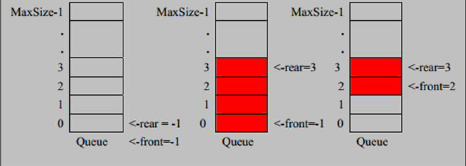队列:数组模拟队列
一、队列介绍
1)队列是一个有序列表,可以用数组或是链表来实现
2)遵循先入先出的原则。即:先存入队列的数据,要先取出,后存入的要后取出
3)示意图:(使用数组模拟队列示意图)

二、数组模拟队列思路
1)队列本身是有序列表,若使用数组的结构来存储队列的数据,则队列数组的声明如下图,其中maxSize是该队列的最大容量。
2)因为队列的输出、输入是分别从前后端来处理,因此需要两个变量front及rear分别记录队列前后端的下标,front会随着数据输出而改变,而rear则是随着数据输入而改变,如下图:

3)当我们将数据存入队列时称为“addQueue”,addQueue的处理需要两个步骤,思路分析
1)将尾指针往后移:rear + 1,当front == rear,则队列为空
2)若尾指针rear小于队列的最大小标maxSize-1,则将数据存入rear所指的数组元素中,否则无法存入数据,若rear ==maxSize -1,队列满
三、代码实现
public class ArrayQueueDemo {
public static void main(String[] args) {
//测试
//创建一个队列
ArrayQueue arrayQueue = new ArrayQueue(3);
char key = ' '; //接收用户输入
Scanner scanner = new Scanner(System.in); //从键盘接收数据
boolean loop = true;
//输出一个菜单
while(loop) {
System.out.println("s(show):显示队列");
System.out.println("e(exit):退出程序");
System.out.println("a(add):添加数据到队列");
System.out.println("g(get):从队列取出数据");
System.out.println("h(head):查看队列头的数据");
key = scanner.next().charAt(0); // 接收一个字符
switch(key) {
case 's': //显示队列
arrayQueue.showQueue();
break;
case 'a': //添加数据
System.out.println("输出一个数");
int value = scanner.nextInt();
arrayQueue.addQueue(value);
break;
case 'g': //取出数据
try {
int res = arrayQueue.getQueue();
System.out.printf("取出的数据是%d
",res);
} catch (Exception e) {
// TODO: handle exception
System.out.println(e.getMessage());
}
break;
case 'h': //查看队列头的数据
try {
int res = arrayQueue.headQueue();
System.out.printf("队列头的数据是%d
",res);
} catch (Exception e) {
// TODO: handle exception
System.out.println(e.getMessage());
}
break;
case 'e': //退出
scanner.close();
loop = false;
break;
default:
break;
}
}
System.out.println("程序退出");
}
}
//使用数组模拟列表-编写一个ArrayQueue类
class ArrayQueue {
private int maxSize; //表示数组的最大容量
private int front; //队列头
private int rear; //队列尾
private int[] arr; //该数据用于存放数据,模拟队列
//创建队列的构造器
public ArrayQueue(int arrMaxSize) {
super();
this.maxSize = arrMaxSize;
arr = new int[maxSize];
front = -1; //指向队列头部,分析出front是指向队列头的前一个位置
rear = -1; //指向队列尾,指向队列尾的数据(即队列最后一个数据)
}
//判断队列是否满
public boolean isFull() {
return rear == maxSize -1;
}
//判断队列是否为空
public boolean isEmpty() {
return rear == front;
}
//添加数据到队列
public void addQueue(int n) {
//判断队列是否满
if(isFull()) {
System.out.println("队列满,不能加入输~");
return;
}
rear++; //让rear后移
arr[rear] = n;
}
//获取队列的数据,出队列
public int getQueue() {
//判断队列是否为空
if(isEmpty()) {
//通过抛出异常
throw new RuntimeException("队列为空,不能取数据");
}
front++; //front后移
return arr[front];
}
//显示队列的所有数据
public void showQueue() {
//遍历
if(isEmpty()) {
System.out.println("队列为空,没有数据 ~");
return;
}
for(int i = 0; i < arr.length; i++) {
System.out.printf("arr[%d]=%d
",i,arr[i]);
}
}
//显示队列的头数据,注意不是取出数据
public int headQueue() {
//判断
if(isEmpty()) {
throw new RuntimeException("队列为空,没有数据~");
}
return arr[front + 1];
}
}